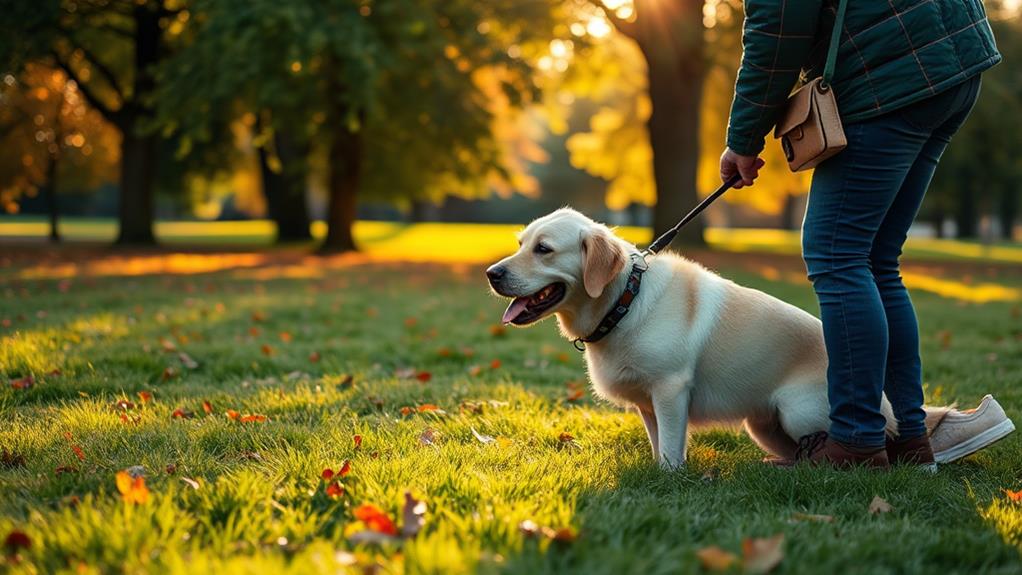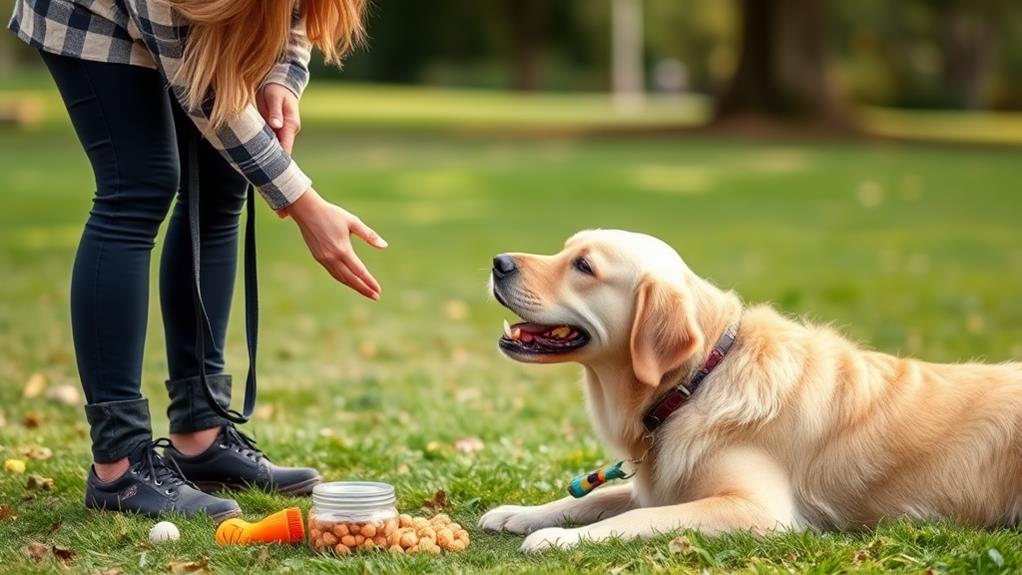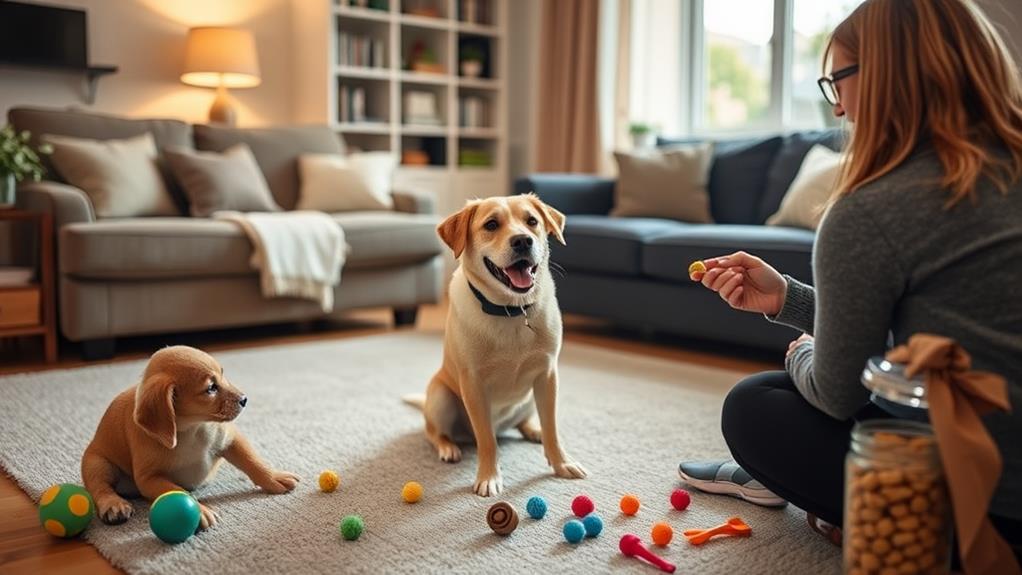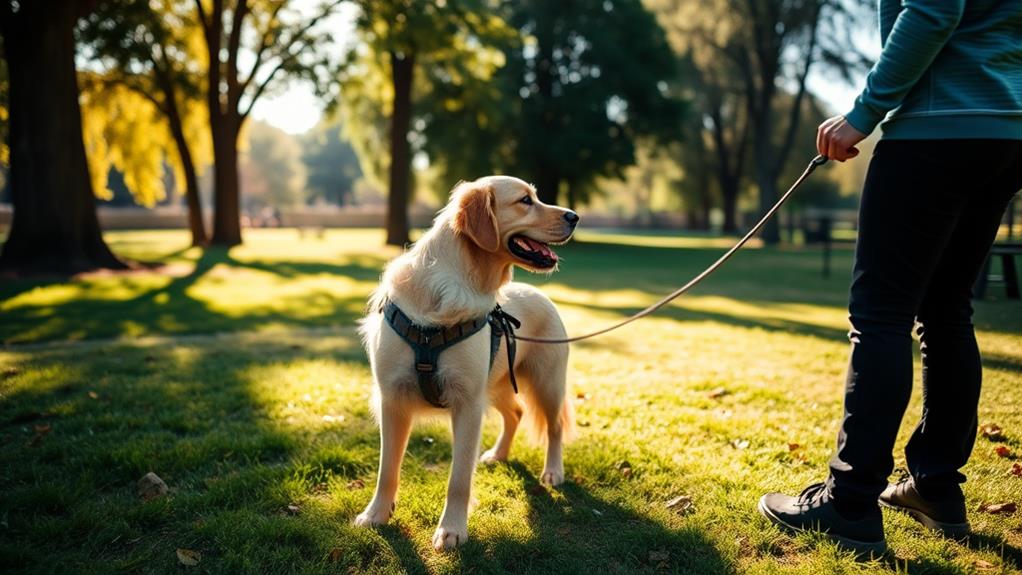Tailored training techniques for your aging canine focus on adapting to their changing needs. Simplify commands and break tasks into smaller steps to avoid overwhelming them. Use positive reinforcement, like treats or praise, immediately after they succeed, and keep sessions short—around 5 to 10 minutes—to maintain their interest. Pay close attention to signs of fatigue, such as drooping tails or decreased enthusiasm, so you can adjust accordingly. Create a calm, familiar environment to help your pup thrive. If you explore further, you'll discover even more strategies to enrich your dog's training experience and overall well-being.
Understanding Aging Canines

As your dog ages, it's pivotal to understand the changes they go through both physically and mentally. You might notice they slow down, struggle to jump, or have difficulty getting up from lying down. Their joints may become stiff, making regular exercise more challenging. Pay attention to these signs, as they indicate your dog's need for comfort and care.
Mentally, aging canines may experience cognitive decline, which can manifest as confusion, forgetfulness, or altered sleep patterns. You might find your dog staring blankly or pacing, behaviors that can be distressing for both of you. It's essential to remain patient and supportive, as these changes can be overwhelming for them.
Furthermore, their senses may diminish; hearing and sight mightn't be as sharp as they once were. This change can make it harder for them to respond to commands or navigate their environment. Keeping their surroundings familiar and using clear cues can help them adjust. Understanding these physical and mental transformations allows you to provide the best care and support, ensuring your aging canine continues to lead a fulfilling life.
Modifying Training Approaches

Recognizing the physical and mental changes in your aging dog can help you adjust your training techniques to better suit their needs. As your dog ages, they may experience decreased mobility, slower reactions, or cognitive decline. It's important to modify your training approaches accordingly.
Start by simplifying commands. Use clear, concise words and gestures, as your dog might struggle to process complex instructions. Break tasks into smaller steps to help them grasp new concepts without feeling overwhelmed. Patience is key—encourage your dog with a calm demeanor, allowing them time to respond.
Consider the training environment as well. Choose quieter settings with fewer distractions, so your dog can focus better. Keep training sessions short and engaging, as longer sessions may lead to fatigue or frustration.
Incorporate gentle exercises that cater to their physical limitations, ensuring it remains fun and stimulating. Remember, consistency is indispensable. Stick to a routine to help your dog feel secure and confident in their training. By modifying your approaches, you not only support your aging canine but also strengthen the bond you share.
Incorporating Positive Reinforcement

Incorporating positive reinforcement is essential for training your aging dog effectively. This method focuses on rewarding desirable behaviors rather than punishing undesirable ones, creating a supportive environment for your furry friend. Dogs learn best when they feel safe and appreciated, especially as they age. Here are some key strategies to contemplate:
| Behavior | Reward | Timing |
|---|---|---|
| Sit | Treat or praise | Immediately after |
| Stay | Belly rub | As long as they hold |
| Come | Favorite toy | Upon arrival |
| Heel | Clicker sound | When they're close |
| Leave it | Special snack | As they stop trying |
Start by identifying the behaviors you want to reinforce, and choose rewards that motivate your dog. Use treats, toys, or even affection, depending on what excites them the most. Timing is pivotal; offer the reward immediately after the desired behavior to help your dog make the connection. With patience and consistency, you'll not only enhance your dog's learning but also strengthen your bond, making training an enjoyable experience for both of you.
Keeping Sessions Short and Engaging

Keeping training sessions short and engaging is essential for your aging dog's focus and enthusiasm. Aim for sessions that last between 5 to 10 minutes. This way, you keep your dog's attention without overwhelming them. Break down commands or tricks into smaller, manageable parts, allowing for quick wins that keep your dog motivated.
Incorporate a variety of activities to maintain interest. Use different locations, toys, or even treat types to keep things fresh. Mixing up the routine can spark curiosity and excitement. Don't forget to include playtime or a favorite game as a reward, reinforcing the fun aspect of learning.
Stay attuned to your dog's body language and energy levels. If they seem restless or distracted, it might be a sign to wrap things up. Positive reinforcement remains pivotal; use treats and praise to celebrate each small success, which helps build confidence and encourages enthusiasm.
Lastly, consistency is key. Regular, brief sessions are more effective than infrequent long ones, helping your dog retain what they learn. By keeping training short and engaging, you create a positive experience that fosters a lifelong love for learning.
Recognizing Signs of Fatigue

Your dog's well-being is closely tied to how well you can read their signs of fatigue during training. As your canine ages, they may not bounce back from exertion like they used to. Watch for subtle cues that indicate they're tired. When their tail droops or their ears lay back, it's often a sign they need a reprieve.
You might also notice a decrease in enthusiasm; if your dog's normally eager to participate but suddenly seems indifferent, it's time to pause. Heavy panting, lagging behind, or lying down can indicate they're reaching their limit.
Pay attention to their body language. If they're avoiding eye contact or turning away from you, they may be overwhelmed. It's crucial to stay attuned to these signals to prevent overexertion and maintain training as a positive experience.
Frequently Asked Questions
What Specific Age Qualifies a Dog as a Senior Canine?
A dog typically qualifies as a senior around seven years old, though this can vary by breed. Larger breeds often age faster, becoming seniors by five or six, while smaller breeds may remain youthful longer.
Can Old Dogs Learn New Tricks Effectively?
You know the saying, "You can't teach an old dog new tricks," right? But don't believe it! Old dogs can learn effectively with patience and love, proving that age is just a number when it comes to learning.
Are There Any Training Tools Designed for Aging Dogs?
Yes, there are training tools designed specifically for aging dogs. You can use softer leashes, gentle clickers, and treat-dispensing toys to keep your dog's interest high while accommodating their physical limitations and enhancing their learning experience.
How Can I Motivate My Senior Dog During Training?
Motivating your senior dog's like coaxing a reluctant flower to bloom. Use tasty treats, gentle praise, and short, engaging sessions. Keep the atmosphere positive, and soon you'll see that spark of enthusiasm return.
Is Outdoor Training Safe for Aging Canines?
Outdoor training can be safe for your aging canine, as long as you take precautions. Keep sessions short, choose shaded areas, and watch for signs of fatigue. Always stay hydrated and adjust activities to your dog's needs.
Conclusion
Incorporating tailored training techniques for your aging canine isn't just about keeping them active; it's about deepening your bond. You might worry that they're too old to learn new tricks, but remember, every small success boosts their confidence and enriches their quality of life. By adjusting your approach, using positive reinforcement, and keeping sessions brief, you're not only teaching them but also showing them how much you care. Embrace this journey together; the rewards are immeasurable.



